and not in the mood for sharing.
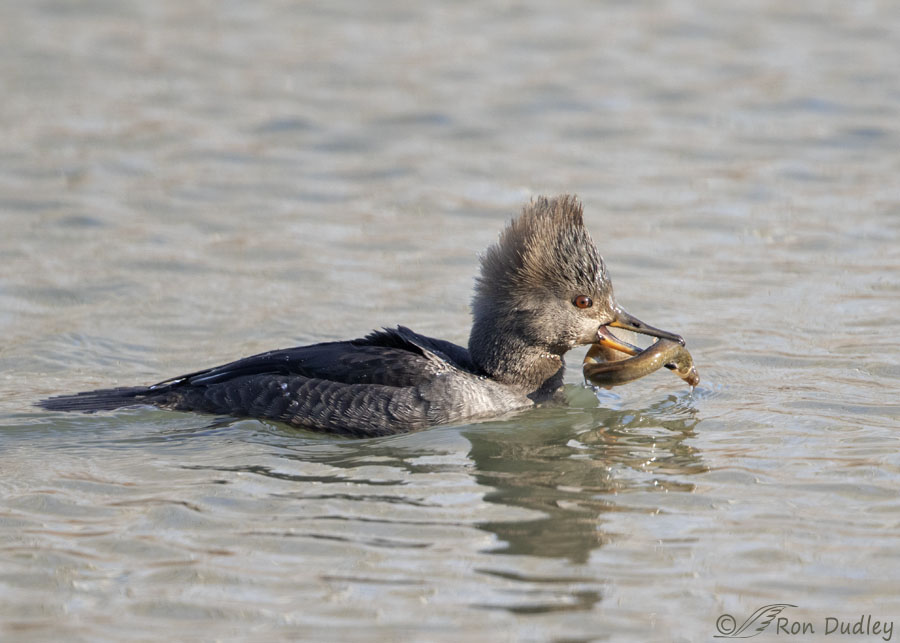
1/1250, f/5.6, ISO 800, Canon 7D Mark II, Canon EF 500mm f/4L IS II USM + EF 1.4 III Extender, not baited, set up or called in
Almost exactly one year ago I spent some time with a pair of Hooded Mergansers who were both actively fishing at one of the local ponds I frequent. I believe they were a mated pair because this species is seasonally monogamous, they pair up as early as November and most of the time these two birds acted as if they were bonded.
Both mergansers were excellent fishermen. In my time with them each of them caught three or four fish and every one of them was a Weather Loach (Dojo Loach), an eel-like invasive species that now populates many of our inland waterways across the country. It is believed that Weather Loaches gained their foothold in our ponds and streams from illegal releases by home aquarists (people who keep tropical fish in aquariums).
This is the female merganser with an unusually large loach – most are smaller than this. Loaches are a writhing, squirming mouthful to try to get down the hatch.
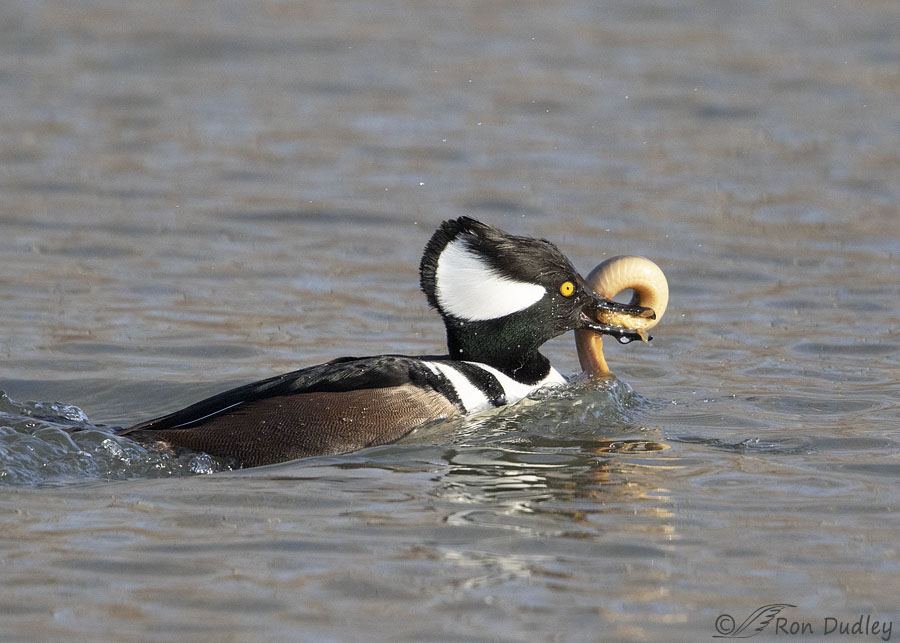
1/3200, f/5.6, ISO 800, Canon 7D Mark II, Canon EF 500mm f/4L IS II USM + EF 1.4 III Extender, not baited, set up or called in
Not to be outdone her mate caught an even larger loach, perhaps the largest I’ve ever seen and I’ve photographed many bird species eating loaches.
This male was swimming fast for very good reason. Most times he caught a fish his mate tried to steal it. Truly, the female merganser reminded me of my ex-wife who was constantly stealing food off of my plate whenever we ate out. I remember thinking about that comparison while I was photographing these birds.
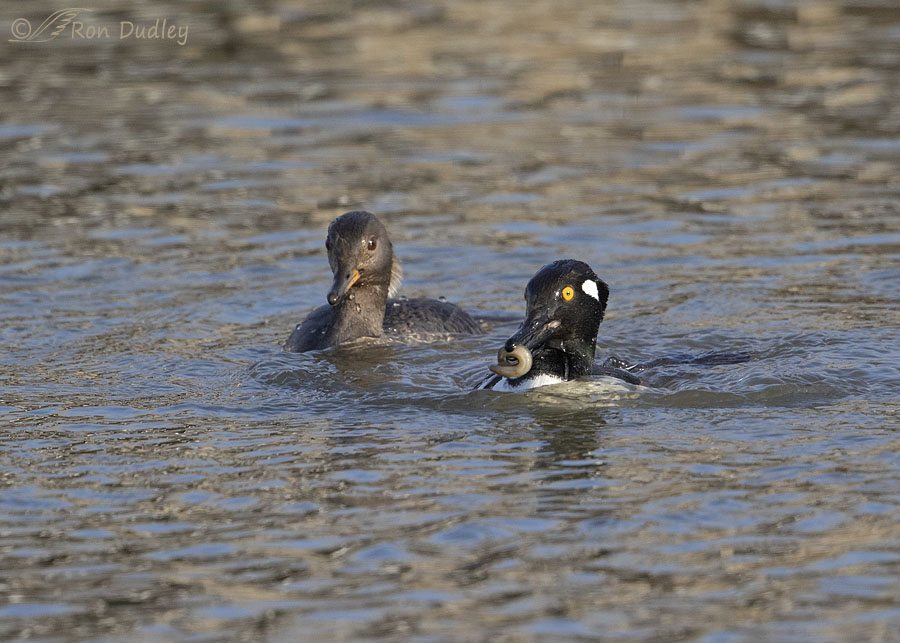
1/2500, f/6.3, ISO 800, Canon 7D Mark II, Canon EF 500mm f/4L IS II USM + EF 1.4 III Extender, not baited, set up or called in
Here the male has caught a more typically sized loach and his mate has her eye on it. Typically her strategy for fish-stealing wasn’t direct confrontation. Instead she would look all innocent and then…
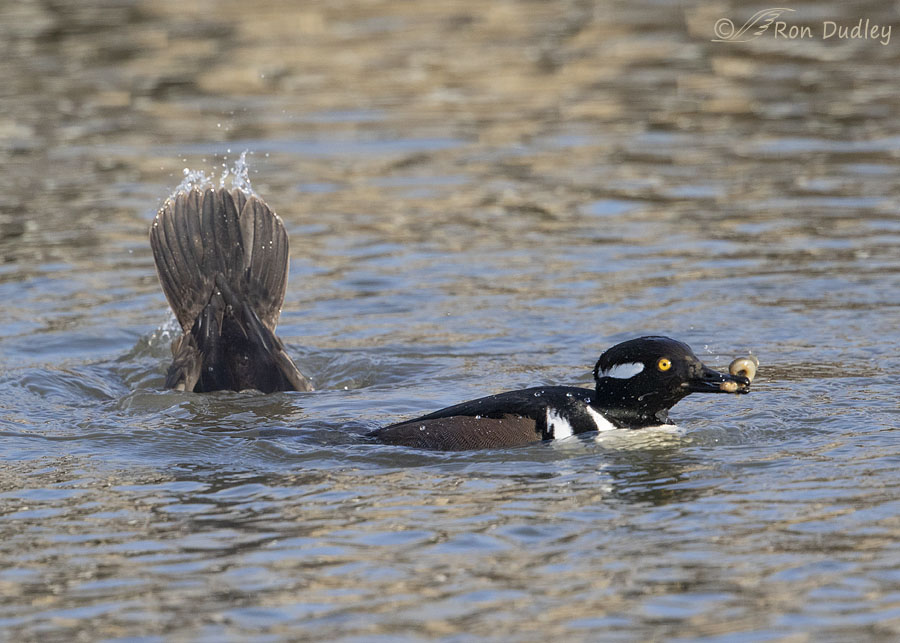
1/2000, f/6.3, ISO 800, Canon 7D Mark II, Canon EF 500mm f/4L IS II USM + EF 1.4 III Extender, not baited, set up or called in
dive with the intention of surfacing directly in front of her mate and quickly snatching his fish. Just from the look on his face it’s obvious that he was fully aware of what she intended to do.
1/4000, f/5.6, ISO 800, Canon 7D Mark II, Canon EF 500mm f/4L IS II USM + EF 1.4 III Extender, not baited, set up or called in
So every time he caught a fish he tried to put a comfortable distance between them before he attempted to swallow his squirming and slippery meal. Even though she was persistent he was usually, perhaps always, successful in holding on to his fish and eventually gulping it down.
Hooded Mergansers are visual underwater foragers and their eyesight in water is unusually good. Unlike many ducks they can “dramatically alter the refractive properties of their eyes through accommodative lens changes” which corrects the challenges of refraction in water.
When combined with their unusually transparent nictitating membranes (seen in the 4th photo above) they’re extremely well adapted to finding and pursuing underwater prey, including but not limited to just fish.
Ron


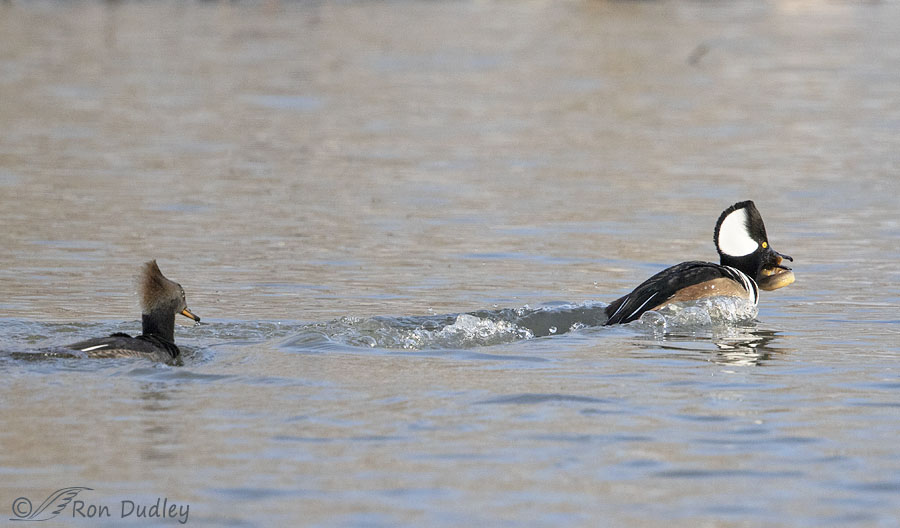
I laughed at the comparisons and yuck, don’t think much of the loaches, but they seem to like them, or don’t have much choice.
Love the first photo. She is a beauty!
Thank you, Jean.
Thought it might be appropriate to copy this link from Birdnote about nictitating membranes:
https://www.birdnote.org/show/nictitating-membranes-natures-goggles.
Hope you don’t mind. Who knew birds and Polar Bears both have them?
I once read that the tiny red flap at the inner corner of the eyes of humans is a vestigial nictitans.
Thanks, I see it now. And that should be kleptoparasitism. I must have had the present administration in the back of my mind when I typed kleptocracy.
Perfect, Lyle. Perfect!
Fascinating! And of course great photos!
Thank you, Joanne.
Yet ANOTHER great series. She had really embraced ‘what’s yours is mine’ hadn’t she, even if he was a tad more reluctant. I am glad that she was also an adept fisher. You are right I have never seen such humungous loaches. They obviously thrive there – until they become lunch.
Thanks Ron.
EC, it made me curious as to why he didn’t react to her fish the way she did to his. If he ever did I didn’t notice it and I was paying attention…
Hoods up, hoods down, dietary preferences, kleptocracy (bird and human) as a part of (apparent) bonding behavior, catch lights in both birds eyes in the third photo, invasive species, nictitating membrane (admittedly not sure I can detect it, though), refractive abilities of eyes while underwater, a mean wake behind the escaping male in the last photo and a generally wonderful photo sequence. Have I missed anything? Oh yeah, thanks for sharing.
Thanks, Lyle. Didn’t know I’d covered that much.
The leading edge of the membrane is darker so in that photo the membrane is half open and half closed. We can see the eye through the membrane almost as well as when we’re not looking through it.
REALLY nice series and education, Ron! Why hunt if you can steal it?
Why hunt if you can steal it?  Always amazing what “innocent” fish/whatever can become a REAL problem in the environment even if it does provide food for some critters. Had those “weather loaches” in an aquarium many years ago – didn’t do well there as I remember. … Our “promised” warmer weather hasn’t arrived – keep pushing it off another day or two….
Always amazing what “innocent” fish/whatever can become a REAL problem in the environment even if it does provide food for some critters. Had those “weather loaches” in an aquarium many years ago – didn’t do well there as I remember. … Our “promised” warmer weather hasn’t arrived – keep pushing it off another day or two…. 
 -10 with -20 windchill at the moment…..
-10 with -20 windchill at the moment…..
Judy, I had several aquariums over the years but I’d never heard of a Weather Loach until an ichthyologist at DNR identified them in some of my photos of birds eating them.
Pretty fun post today ! He’s really got his little outboard motoring in that last photo…..I’ll bet your ex-“mate” wouldn’t have gone after your
plate if you’d been dining on loaches—yech ! Are they slimy-squirmy looking critters……thanks for the entertainment this snowy AM.
“I’ll bet your ex-“mate” wouldn’t have gone after your
plate if you’d been dining on loaches”
I dunno, Kris. It was pretty automatic for her. Sometime I swear she didn’t even notice what she was swiping…
What an outstanding post Ron. Educational, fun, and of course great photos. I think you are right about the origin of that species in your pond. I have never seen a loach brought up by a Merganser, Goldeneye, or a Grebe, I don’t think we have them in our lakes. In that last photo he appears to be really steaming away from his mate.
Everett, I’ve photographed mergansers, goldeneyes, herons, kingfishers and two grebe species eating loaches. And perhaps some others that I’m not remembering at the moment. Loaches seem to be in many if not most of our ponds, streams and lakes, including those in refuges like Bear River and Farmington.